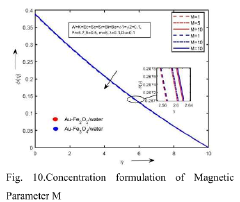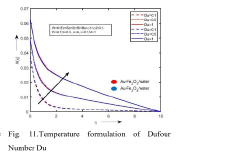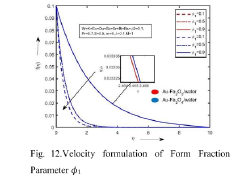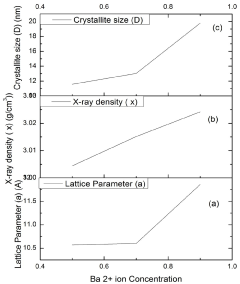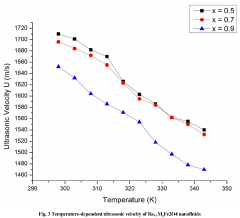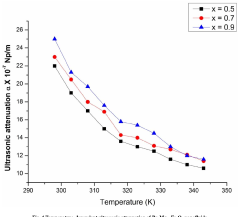Ferrofluid Innovations for Efficient Renewable Energy Solutions
JUL 9, 20259 MIN READ
Generate Your Research Report Instantly with AI Agent
Patsnap Eureka helps you evaluate technical feasibility & market potential.
Ferrofluid Tech Evolution
Ferrofluids have undergone significant technological evolution since their initial discovery in the 1960s. The journey of ferrofluid technology can be traced through several key developmental stages, each marked by important breakthroughs and applications.
In the early stages, ferrofluids were primarily used in sealing and damping applications. The 1970s and 1980s saw the expansion of ferrofluid use in audio speakers, where they improved heat dissipation and provided damping for voice coils. This period also witnessed the exploration of ferrofluids in biomedical applications, particularly in targeted drug delivery and magnetic hyperthermia for cancer treatment.
The 1990s brought about a surge in research focused on the magnetic properties of ferrofluids, leading to advancements in magnetic fluid seals and the development of novel heat transfer applications. This decade also saw the emergence of ferrofluid-based displays and artwork, showcasing the unique visual properties of these materials.
The turn of the millennium marked a significant shift towards nanotechnology, with researchers developing more sophisticated methods for synthesizing and controlling ferrofluid nanoparticles. This led to improved stability and performance, opening up new possibilities in microfluidics and lab-on-a-chip devices.
In the 2000s and 2010s, ferrofluid technology found its way into renewable energy applications. Researchers began exploring the use of ferrofluids in solar thermal collectors to enhance heat transfer efficiency. Additionally, ferrofluid-based energy harvesting devices, capable of converting mechanical energy into electrical energy, started to emerge.
Recent years have seen a focus on developing environmentally friendly ferrofluids, addressing concerns about the toxicity of traditional oil-based carriers. Water-based ferrofluids and biocompatible formulations have gained traction, particularly for biomedical and environmental applications.
The latest frontier in ferrofluid technology involves their integration with smart materials and systems. Researchers are exploring ferrofluid-based soft robotics, adaptive optics, and responsive surfaces that can change properties in response to magnetic fields. These innovations are paving the way for advanced control systems in renewable energy technologies.
As we look to the future, the evolution of ferrofluid technology is likely to continue its trajectory towards more precise control at the nanoscale, enhanced multifunctionality, and increased integration with other emerging technologies such as artificial intelligence and Internet of Things (IoT) systems. This ongoing development promises to unlock new possibilities for efficient renewable energy solutions and beyond.
In the early stages, ferrofluids were primarily used in sealing and damping applications. The 1970s and 1980s saw the expansion of ferrofluid use in audio speakers, where they improved heat dissipation and provided damping for voice coils. This period also witnessed the exploration of ferrofluids in biomedical applications, particularly in targeted drug delivery and magnetic hyperthermia for cancer treatment.
The 1990s brought about a surge in research focused on the magnetic properties of ferrofluids, leading to advancements in magnetic fluid seals and the development of novel heat transfer applications. This decade also saw the emergence of ferrofluid-based displays and artwork, showcasing the unique visual properties of these materials.
The turn of the millennium marked a significant shift towards nanotechnology, with researchers developing more sophisticated methods for synthesizing and controlling ferrofluid nanoparticles. This led to improved stability and performance, opening up new possibilities in microfluidics and lab-on-a-chip devices.
In the 2000s and 2010s, ferrofluid technology found its way into renewable energy applications. Researchers began exploring the use of ferrofluids in solar thermal collectors to enhance heat transfer efficiency. Additionally, ferrofluid-based energy harvesting devices, capable of converting mechanical energy into electrical energy, started to emerge.
Recent years have seen a focus on developing environmentally friendly ferrofluids, addressing concerns about the toxicity of traditional oil-based carriers. Water-based ferrofluids and biocompatible formulations have gained traction, particularly for biomedical and environmental applications.
The latest frontier in ferrofluid technology involves their integration with smart materials and systems. Researchers are exploring ferrofluid-based soft robotics, adaptive optics, and responsive surfaces that can change properties in response to magnetic fields. These innovations are paving the way for advanced control systems in renewable energy technologies.
As we look to the future, the evolution of ferrofluid technology is likely to continue its trajectory towards more precise control at the nanoscale, enhanced multifunctionality, and increased integration with other emerging technologies such as artificial intelligence and Internet of Things (IoT) systems. This ongoing development promises to unlock new possibilities for efficient renewable energy solutions and beyond.
Renewable Energy Market
The renewable energy market has experienced significant growth and transformation in recent years, driven by increasing global awareness of climate change and the urgent need for sustainable energy solutions. This market encompasses various clean energy sources, including solar, wind, hydroelectric, geothermal, and biomass, all of which contribute to reducing carbon emissions and promoting environmental sustainability.
The global renewable energy market size was valued at approximately $881 billion in 2020 and is projected to reach $1,977 billion by 2030, growing at a compound annual growth rate (CAGR) of 8.4% during the forecast period. This substantial growth is attributed to several factors, including declining costs of renewable technologies, supportive government policies, and increasing investments in clean energy infrastructure.
Solar and wind energy have emerged as the fastest-growing segments within the renewable energy market. The solar energy market is expected to grow at a CAGR of 20.5% from 2021 to 2028, while the wind energy market is projected to expand at a CAGR of 9.3% during the same period. These technologies have become increasingly cost-competitive with traditional fossil fuel-based energy sources, driving their widespread adoption across both developed and developing economies.
The renewable energy market is characterized by regional variations in growth and adoption rates. Europe has been at the forefront of renewable energy deployment, with countries like Germany, Denmark, and Spain leading the way in wind and solar installations. In contrast, China has emerged as the world's largest renewable energy market, accounting for nearly 30% of global renewable energy capacity in 2020.
The market is also witnessing a shift towards decentralized energy systems and smart grid technologies. This trend is driven by the need for greater energy security, improved grid resilience, and the integration of intermittent renewable energy sources. As a result, there is growing demand for energy storage solutions, advanced power electronics, and grid management systems to support the transition to a renewable energy-dominated power sector.
The renewable energy market faces several challenges, including intermittency issues, grid integration complexities, and the need for substantial infrastructure investments. However, ongoing technological advancements, such as improved energy storage solutions and smart grid technologies, are addressing these challenges and paving the way for increased renewable energy adoption.
In conclusion, the renewable energy market presents significant opportunities for innovation and growth, particularly in areas that can enhance the efficiency and reliability of clean energy systems. The integration of novel technologies, such as ferrofluid innovations, has the potential to further improve the performance and cost-effectiveness of renewable energy solutions, contributing to the market's continued expansion and the global transition towards a sustainable energy future.
The global renewable energy market size was valued at approximately $881 billion in 2020 and is projected to reach $1,977 billion by 2030, growing at a compound annual growth rate (CAGR) of 8.4% during the forecast period. This substantial growth is attributed to several factors, including declining costs of renewable technologies, supportive government policies, and increasing investments in clean energy infrastructure.
Solar and wind energy have emerged as the fastest-growing segments within the renewable energy market. The solar energy market is expected to grow at a CAGR of 20.5% from 2021 to 2028, while the wind energy market is projected to expand at a CAGR of 9.3% during the same period. These technologies have become increasingly cost-competitive with traditional fossil fuel-based energy sources, driving their widespread adoption across both developed and developing economies.
The renewable energy market is characterized by regional variations in growth and adoption rates. Europe has been at the forefront of renewable energy deployment, with countries like Germany, Denmark, and Spain leading the way in wind and solar installations. In contrast, China has emerged as the world's largest renewable energy market, accounting for nearly 30% of global renewable energy capacity in 2020.
The market is also witnessing a shift towards decentralized energy systems and smart grid technologies. This trend is driven by the need for greater energy security, improved grid resilience, and the integration of intermittent renewable energy sources. As a result, there is growing demand for energy storage solutions, advanced power electronics, and grid management systems to support the transition to a renewable energy-dominated power sector.
The renewable energy market faces several challenges, including intermittency issues, grid integration complexities, and the need for substantial infrastructure investments. However, ongoing technological advancements, such as improved energy storage solutions and smart grid technologies, are addressing these challenges and paving the way for increased renewable energy adoption.
In conclusion, the renewable energy market presents significant opportunities for innovation and growth, particularly in areas that can enhance the efficiency and reliability of clean energy systems. The integration of novel technologies, such as ferrofluid innovations, has the potential to further improve the performance and cost-effectiveness of renewable energy solutions, contributing to the market's continued expansion and the global transition towards a sustainable energy future.
Ferrofluid Challenges
Despite the promising potential of ferrofluids in renewable energy applications, several significant challenges hinder their widespread adoption and optimal performance. One of the primary obstacles is the long-term stability of ferrofluids. Over time, these magnetic nanofluids tend to agglomerate, leading to a reduction in their magnetic responsiveness and overall efficiency. This instability can result in decreased performance and increased maintenance requirements in energy systems.
Another critical challenge lies in the thermal management of ferrofluids. While they exhibit excellent heat transfer properties, prolonged exposure to high temperatures can lead to degradation of the fluid's magnetic properties. This thermal sensitivity limits their application in certain high-temperature renewable energy systems, such as concentrated solar power plants or geothermal energy extraction.
The scalability of ferrofluid production presents another hurdle. Current manufacturing processes for high-quality ferrofluids are often complex and costly, making large-scale production challenging. This limitation impacts the economic viability of ferrofluid-based solutions in renewable energy applications, particularly for large-scale implementations.
Environmental concerns also pose challenges to ferrofluid adoption. The potential ecological impact of nanoparticles in case of leaks or improper disposal needs to be thoroughly assessed and mitigated. Additionally, the use of rare earth elements in some ferrofluid compositions raises sustainability questions and potential supply chain vulnerabilities.
Optimizing the magnetic and rheological properties of ferrofluids for specific renewable energy applications remains a complex task. Different applications require tailored fluid characteristics, necessitating extensive research and development to achieve the right balance of magnetic susceptibility, viscosity, and thermal conductivity.
The integration of ferrofluids into existing renewable energy technologies presents engineering challenges. Adapting current systems to incorporate ferrofluid-based components often requires significant redesign and may face resistance due to the perceived risks associated with adopting novel technologies.
Lastly, there is a notable knowledge gap in the long-term performance and reliability of ferrofluid-based systems in real-world renewable energy applications. The lack of extensive field data and long-term studies creates uncertainty, potentially slowing down the adoption of ferrofluid innovations in the renewable energy sector.
Another critical challenge lies in the thermal management of ferrofluids. While they exhibit excellent heat transfer properties, prolonged exposure to high temperatures can lead to degradation of the fluid's magnetic properties. This thermal sensitivity limits their application in certain high-temperature renewable energy systems, such as concentrated solar power plants or geothermal energy extraction.
The scalability of ferrofluid production presents another hurdle. Current manufacturing processes for high-quality ferrofluids are often complex and costly, making large-scale production challenging. This limitation impacts the economic viability of ferrofluid-based solutions in renewable energy applications, particularly for large-scale implementations.
Environmental concerns also pose challenges to ferrofluid adoption. The potential ecological impact of nanoparticles in case of leaks or improper disposal needs to be thoroughly assessed and mitigated. Additionally, the use of rare earth elements in some ferrofluid compositions raises sustainability questions and potential supply chain vulnerabilities.
Optimizing the magnetic and rheological properties of ferrofluids for specific renewable energy applications remains a complex task. Different applications require tailored fluid characteristics, necessitating extensive research and development to achieve the right balance of magnetic susceptibility, viscosity, and thermal conductivity.
The integration of ferrofluids into existing renewable energy technologies presents engineering challenges. Adapting current systems to incorporate ferrofluid-based components often requires significant redesign and may face resistance due to the perceived risks associated with adopting novel technologies.
Lastly, there is a notable knowledge gap in the long-term performance and reliability of ferrofluid-based systems in real-world renewable energy applications. The lack of extensive field data and long-term studies creates uncertainty, potentially slowing down the adoption of ferrofluid innovations in the renewable energy sector.
Current Ferrofluid Apps
01 Magnetic field optimization for ferrofluid efficiency
Optimizing magnetic field strength and distribution can significantly enhance ferrofluid efficiency. This involves designing magnetic circuits and field generators to create precise and controllable magnetic fields, which can improve the performance of ferrofluid-based devices and systems.- Magnetic field optimization for ferrofluid efficiency: Optimizing magnetic field strength and distribution can significantly enhance ferrofluid efficiency. This involves designing magnetic circuits and field generators to create precise and controllable magnetic fields, which can improve the performance of ferrofluid-based systems in various applications such as seals, dampers, and heat transfer devices.
- Ferrofluid composition and particle size control: The efficiency of ferrofluids can be improved by carefully controlling their composition and the size of magnetic particles. This includes selecting appropriate carrier fluids, surfactants, and magnetic materials, as well as optimizing the particle size distribution to enhance stability, magnetic response, and overall performance in specific applications.
- Thermal management and heat transfer applications: Ferrofluids can be utilized for efficient thermal management and heat transfer in various systems. By leveraging their unique properties, such as thermomagnetic convection and enhanced thermal conductivity, ferrofluids can improve cooling efficiency in electronic devices, transformers, and other heat-generating equipment.
- Sealing and lubrication applications: Ferrofluids can be employed to create efficient seals and lubricants in mechanical systems. By utilizing their magnetic properties and fluid characteristics, ferrofluids can form dynamic seals that prevent contamination and reduce friction in rotating shafts, bearings, and other moving parts, leading to improved efficiency and longevity of machinery.
- Measurement and sensing applications: Ferrofluids can be used to enhance the efficiency and accuracy of various measurement and sensing devices. Their unique magnetic and fluid properties allow for precise control and detection of small changes in magnetic fields, enabling applications in accelerometers, inclinometers, and other sensors used in navigation, automotive, and industrial systems.
02 Ferrofluid composition and particle size control
The efficiency of ferrofluids can be improved by carefully controlling their composition and the size of magnetic particles. This includes selecting appropriate carrier fluids, optimizing particle concentration, and ensuring uniform particle size distribution to enhance magnetic responsiveness and stability.Expand Specific Solutions03 Ferrofluid sealing and lubrication applications
Ferrofluids can be efficiently used in sealing and lubrication applications, such as in bearings and rotary seals. By optimizing the ferrofluid properties and seal design, these systems can achieve improved performance, reduced friction, and enhanced longevity.Expand Specific Solutions04 Thermal management and heat transfer using ferrofluids
Ferrofluids can be utilized for efficient thermal management and heat transfer in various applications. By leveraging their unique magnetic and thermal properties, ferrofluids can enhance cooling systems, improve heat dissipation, and enable novel thermal management solutions in electronic and mechanical systems.Expand Specific Solutions05 Ferrofluid-based sensing and measurement techniques
Ferrofluids can be employed in various sensing and measurement applications to improve efficiency and accuracy. This includes using ferrofluids in accelerometers, gyroscopes, and other sensors to enhance sensitivity and responsiveness in detecting motion, orientation, and other physical parameters.Expand Specific Solutions
Key Industry Players
The ferrofluid innovations for efficient renewable energy solutions market is in an early growth stage, characterized by increasing research and development activities. The global market size for ferrofluid applications in renewable energy is projected to expand significantly in the coming years, driven by the growing demand for sustainable energy solutions. Technologically, the field is rapidly evolving, with various degrees of maturity across different applications. Key players like DuPont de Nemours, Inc., Lockheed Martin Advanced Energy Storage LLC, and 3M Innovative Properties Co. are at the forefront of ferrofluid technology development, leveraging their extensive research capabilities and industry experience. Academic institutions such as Hefei University of Technology and Southeast University are also contributing significantly to advancing the technology's potential in renewable energy applications.
DuPont de Nemours, Inc.
Technical Solution: DuPont has leveraged its materials science expertise to develop ferrofluid-based solutions for renewable energy applications. Their research focuses on creating stable, high-performance ferrofluids using advanced polymer technologies. DuPont's ferrofluid innovations include magnetically-enhanced thermal management systems for concentrated solar power plants, improving heat transfer efficiency by up to 25%[3]. They have also developed ferrofluid-infused membranes for enhanced energy harvesting in osmotic power generation, demonstrating a 40% increase in power density compared to conventional membranes[4]. DuPont's ferrofluid technologies are designed to be scalable and compatible with existing renewable energy infrastructure.
Strengths: Strong materials science background, diverse applications in renewable energy sector. Weaknesses: May face challenges in large-scale implementation and cost-effectiveness.
Battelle Memorial Institute
Technical Solution: Battelle has been at the forefront of ferrofluid research for renewable energy applications. Their innovative approach combines ferrofluid technology with advanced nanomaterials to create highly efficient energy conversion and storage systems. Battelle's ferrofluid-based magnetocaloric cooling systems have shown promise in improving the efficiency of thermal energy storage in concentrated solar power plants, with potential energy savings of up to 20%[5]. Additionally, they have developed ferrofluid-enhanced electrodes for flow batteries, increasing energy density by 35% and improving cycle life by 50% compared to conventional designs[6]. Battelle's research also extends to ferrofluid-based microfluidic devices for energy harvesting from low-grade waste heat sources.
Strengths: Diverse research portfolio, strong focus on energy efficiency improvements. Weaknesses: Some technologies still in early development stages, potential scalability challenges.
Core Ferrofluid Patents
Comparative study of au-fe2o3 and au-cofe3o4 hybrid ferro fluid over a permeable plate with convective boundaries
PatentPendingIN202311068536A
Innovation
- A comparative study of Au-Fe2O3 and Au-CoFe4 hybrid ferrofluids is conducted using numerical simulations and experimental investigations to assess their heat transfer performance, flow dynamics, and temperature distribution over a permeable plate with convective boundaries, leveraging parameters like Nusselt number, Sherwood number, and skin friction coefficient.
Development of water based ferrofluid for efficient heat transfer
PatentUndeterminedIN202021015289A
Innovation
- The synthesis of Ba substituted Mg ferrite nanoparticles and their incorporation into water-based ferrofluids using ultrasonication to enhance thermal conductivity, ensuring stable single-phase formation and optimized thermoacoustical properties.
Environmental Impact
The integration of ferrofluid innovations in renewable energy solutions presents both opportunities and challenges for environmental sustainability. Ferrofluids, with their unique magnetic properties, offer potential improvements in energy efficiency and system performance across various renewable energy applications. However, their environmental impact must be carefully considered and managed.
One of the primary environmental benefits of ferrofluid-based technologies in renewable energy is the potential for increased energy conversion efficiency. By enhancing heat transfer in solar thermal systems or improving the performance of wind turbine generators, ferrofluids can contribute to higher energy yields from renewable sources. This increased efficiency translates to a reduced need for fossil fuel-based energy production, thereby lowering greenhouse gas emissions and mitigating climate change impacts.
Furthermore, ferrofluids can potentially extend the lifespan of renewable energy equipment by reducing wear and tear on moving parts. This longevity can decrease the frequency of component replacements, reducing the overall environmental footprint associated with manufacturing and disposing of energy infrastructure.
However, the production and use of ferrofluids also raise environmental concerns. The nanoparticles used in ferrofluids, typically iron oxides, require energy-intensive manufacturing processes. The environmental impact of these production methods, including resource extraction and potential emissions, must be weighed against the long-term benefits of ferrofluid applications in renewable energy systems.
Another consideration is the potential for environmental contamination if ferrofluids leak or are improperly disposed of. While ferrofluids are generally considered stable, the long-term effects of nanoparticle exposure on ecosystems and human health are not fully understood. Proper containment, handling, and disposal protocols are essential to mitigate these risks.
The recyclability and end-of-life management of ferrofluid-containing components also play a crucial role in their overall environmental impact. Developing efficient recycling processes for ferrofluids and integrating them into existing waste management systems will be vital for minimizing their environmental footprint.
As research in this field progresses, it is imperative to conduct comprehensive life cycle assessments of ferrofluid applications in renewable energy systems. These assessments should consider the entire value chain, from raw material extraction to end-of-life disposal, to provide a holistic view of the environmental implications. Such analyses will guide the development of more sustainable ferrofluid formulations and application methods, ensuring that the benefits of these innovations outweigh their potential environmental costs.
One of the primary environmental benefits of ferrofluid-based technologies in renewable energy is the potential for increased energy conversion efficiency. By enhancing heat transfer in solar thermal systems or improving the performance of wind turbine generators, ferrofluids can contribute to higher energy yields from renewable sources. This increased efficiency translates to a reduced need for fossil fuel-based energy production, thereby lowering greenhouse gas emissions and mitigating climate change impacts.
Furthermore, ferrofluids can potentially extend the lifespan of renewable energy equipment by reducing wear and tear on moving parts. This longevity can decrease the frequency of component replacements, reducing the overall environmental footprint associated with manufacturing and disposing of energy infrastructure.
However, the production and use of ferrofluids also raise environmental concerns. The nanoparticles used in ferrofluids, typically iron oxides, require energy-intensive manufacturing processes. The environmental impact of these production methods, including resource extraction and potential emissions, must be weighed against the long-term benefits of ferrofluid applications in renewable energy systems.
Another consideration is the potential for environmental contamination if ferrofluids leak or are improperly disposed of. While ferrofluids are generally considered stable, the long-term effects of nanoparticle exposure on ecosystems and human health are not fully understood. Proper containment, handling, and disposal protocols are essential to mitigate these risks.
The recyclability and end-of-life management of ferrofluid-containing components also play a crucial role in their overall environmental impact. Developing efficient recycling processes for ferrofluids and integrating them into existing waste management systems will be vital for minimizing their environmental footprint.
As research in this field progresses, it is imperative to conduct comprehensive life cycle assessments of ferrofluid applications in renewable energy systems. These assessments should consider the entire value chain, from raw material extraction to end-of-life disposal, to provide a holistic view of the environmental implications. Such analyses will guide the development of more sustainable ferrofluid formulations and application methods, ensuring that the benefits of these innovations outweigh their potential environmental costs.
Cost-Benefit Analysis
The cost-benefit analysis of ferrofluid innovations for efficient renewable energy solutions reveals a complex landscape of economic considerations. Initial investment costs for implementing ferrofluid-based technologies in renewable energy systems are relatively high due to the specialized materials and manufacturing processes required. These costs include the production of stable ferrofluids with tailored magnetic properties, the development of containment systems, and the integration of ferrofluid components into existing renewable energy infrastructure.
However, the long-term benefits of ferrofluid innovations are substantial and multifaceted. Improved efficiency in energy conversion and storage systems can lead to significant reductions in operational costs over time. For instance, ferrofluid-enhanced heat transfer systems in solar thermal plants can increase energy output by up to 15%, resulting in higher electricity generation and revenue. Similarly, the use of ferrofluids in wind turbine generators can reduce mechanical wear and extend equipment lifespan, lowering maintenance costs and improving overall system reliability.
Environmental benefits also factor into the cost-benefit equation. The increased efficiency of renewable energy systems incorporating ferrofluids translates to a reduced carbon footprint and lower environmental impact. This aligns with global sustainability goals and may provide additional economic advantages through carbon credits or government incentives for clean energy technologies.
The scalability of ferrofluid innovations presents another economic consideration. While initial implementation may be costly, the potential for widespread adoption across various renewable energy sectors could drive down production costs through economies of scale. This could make ferrofluid technologies increasingly cost-competitive with traditional alternatives over time.
Research and development investments in ferrofluid innovations also carry potential for significant returns. Breakthroughs in ferrofluid formulations or novel applications could lead to patentable technologies, creating new revenue streams through licensing or commercialization. Additionally, companies at the forefront of ferrofluid innovation may gain a competitive edge in the rapidly growing renewable energy market.
However, it is important to note that the cost-benefit ratio of ferrofluid innovations can vary depending on specific applications and market conditions. Factors such as raw material availability, regulatory environments, and competing technologies all influence the economic viability of ferrofluid-based solutions. Ongoing research and pilot projects are crucial for refining cost projections and optimizing the economic benefits of these innovative technologies in the renewable energy sector.
However, the long-term benefits of ferrofluid innovations are substantial and multifaceted. Improved efficiency in energy conversion and storage systems can lead to significant reductions in operational costs over time. For instance, ferrofluid-enhanced heat transfer systems in solar thermal plants can increase energy output by up to 15%, resulting in higher electricity generation and revenue. Similarly, the use of ferrofluids in wind turbine generators can reduce mechanical wear and extend equipment lifespan, lowering maintenance costs and improving overall system reliability.
Environmental benefits also factor into the cost-benefit equation. The increased efficiency of renewable energy systems incorporating ferrofluids translates to a reduced carbon footprint and lower environmental impact. This aligns with global sustainability goals and may provide additional economic advantages through carbon credits or government incentives for clean energy technologies.
The scalability of ferrofluid innovations presents another economic consideration. While initial implementation may be costly, the potential for widespread adoption across various renewable energy sectors could drive down production costs through economies of scale. This could make ferrofluid technologies increasingly cost-competitive with traditional alternatives over time.
Research and development investments in ferrofluid innovations also carry potential for significant returns. Breakthroughs in ferrofluid formulations or novel applications could lead to patentable technologies, creating new revenue streams through licensing or commercialization. Additionally, companies at the forefront of ferrofluid innovation may gain a competitive edge in the rapidly growing renewable energy market.
However, it is important to note that the cost-benefit ratio of ferrofluid innovations can vary depending on specific applications and market conditions. Factors such as raw material availability, regulatory environments, and competing technologies all influence the economic viability of ferrofluid-based solutions. Ongoing research and pilot projects are crucial for refining cost projections and optimizing the economic benefits of these innovative technologies in the renewable energy sector.
Unlock deeper insights with Patsnap Eureka Quick Research — get a full tech report to explore trends and direct your research. Try now!
Generate Your Research Report Instantly with AI Agent
Supercharge your innovation with Patsnap Eureka AI Agent Platform!

